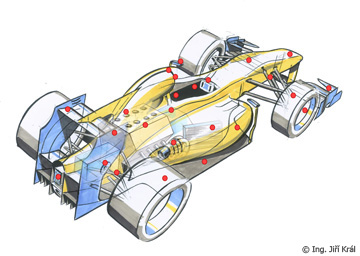2014 Canadian Grand Prix ŌĆō Practice Sessions
Pirelli | 7.6.14 | Pneu Pirelli F1
Pirelli F1
MINIMAL DEGRADATION ON THE SOFT AND SUPERSOFT TYRES
ONE TO TWO PIT STOPS LIKELY IN WHAT IS OFTEN AN UNPREDICTABLE RACE
FERRARI AND MERCEDES FASTEST IN THE TWO FREE PRACTICE SESSIONS
Montreal, June 6, 2014 ŌĆō Despite the heavy traction and braking demands of the Circuit Gilles Villeneuve in Canada, the P Zero Yellow soft and P Zero Red supersoft tyres that have been nominated for this weekend show limited wear and very little degradation. On the supersoft, there was a very small amount of graining. Between one and two pit stops are likely under normal race circumstances.
However, Canada is frequently one of the most unpredictable races of the year, with historically more than a 50% chance of a safety car at some point in proceedings.
A two-stop strategy proved to be the winning choice last year, although in 2013 the medium and supersoft compounds were nominated.
Ferrari driver Fernando Alonso was quickest in the morning session, which was held in cool but dry conditions. In the afternoon, which was hotter, the fastest time was set by Mercedes driver Lewis Hamilton. Only the soft tyre was used during FP1, with the teams moving onto the supersoft in the warmer conditions of the afternoon, which will be representative of qualifying and the race. So far, there is approximately a 0.6 to 0.8-second difference between the two compounds per lap.
As usual, the teams completed both short and then long runs, assessing their pace with different tyres on varying fuel loads. This information will be used to form the basis of the race strategy: although all tactics will need to be flexible to take into account changing opportunities.
Paul Hembery: ŌĆ£Everything went according to plan today, and the warmer weather we experienced this afternoon looks set to remain for the rest of the weekend or possibly become hotter. We obviously need to look at the data tonight, but the indications we are seeing so far suggest that wear and degradation are extremely contained. In terms of wear, the soft tyre could go for 70 laps here and the supersoft for 25. As for degradation, it is negligible for the soft tyre and less than 0.1 seconds per lap for the supersoft. As a result, we would expect to see between one and two pit stops. If temperatures get hotter that pattern could alter, but we are not expecting any significant differences.ŌĆØ
|
FP1: |
|
|
FP2: |
|
|
|
Alonso |
1m17.238s |
Soft New |
Hamilton |
1m16.118s |
Supersoft New |
|
Hamilton |
1m17.254s |
Soft Used |
Rosberg |
1m16.293s |
Supersoft New |
|
Rosberg |
1m17.384s |
Soft Used |
Vettel |
1m16.573s |
Supersoft New |
Tyre statistics of the day:
|
|
Soft |
Supersoft |
Intermediate |
Wet |
|
kms driven * |
3,854 |
1,526 |
N/A |
N/A |
|
sets used overall ** |
66 |
19 |
N/A |
N/A |
|
highest number of laps ** |
32 |
29 |
N/A |
N/A |
* The above number gives the total
amount of kilometres driven in FP1 and FP2 today, all drivers combined.
** Per compound, all drivers
combined.
How does Pirelli choose each tyre for each circuit?
This morning, Pirelli announced the latest
tyre choices up to the Hungarian Grand Prix. But how is each tyre chosen for
each circuit?
PirelliŌĆÖs engineers have an existing data bank relating to the forces at work
on the tyres and wear rates in the past. On top of that there is plenty of
feedback from the teams and statistical information relating to acceleration,
braking, weather conditions and previous race strategy ŌĆō as well as many other
vital parameters.
Together with the known information about how the 2014 compounds behave,
Pirelli can calculate the likely wear rate and the effect of the asphalt on the
tyres at different points on the circuit. These calculations are used to build
up an overall picture of how a tyre is likely to react at each grand prix.
Other important factors are the expected temperatures and tarmac roughness.
With two stops the target at each race as well as a reduced number of ŌĆśmarblesŌĆÖ
by the side of the circuit, the most suitable combination of tyres can then be
selected for each grand prix.
Nonetheless, these are theoretical calculations that cannot replace real data,
as the way that rubber is laid down on the track with 22 very different cars
running over the course of a weekend is impossible to replicate. The challenge
is even greater this year, with vehicle dynamics having altered completely as a result of the 2014 regulations.
Pirelli fact of the day:
Despite some light showers in the morning, the rain held off for both free practice sessions today. However, adverse conditions during PirelliŌĆÖs very first Canadian Grand Prix of the current era, in 2011, resulted in no fewer than three Formula One records being set. The 2011 race was the longest in Formula One history, at four hours and four minutes, after a two-hour stoppage. As a result, it had the lowest average speed of any race ŌĆō just 74.84 kph ŌĆō and the highest number of safety cars: six. The forecast remains dry for the rest of the weekend.




